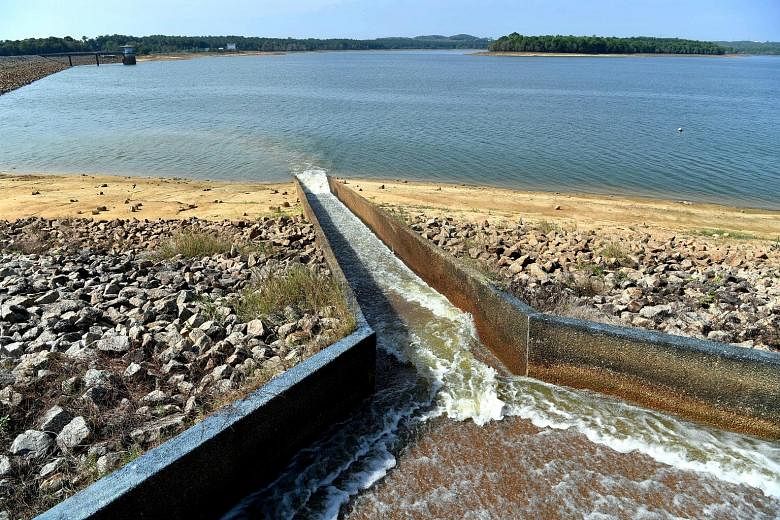PETALING JAYA • The water levels at three dams in Johor, which supply raw water to treatment plants that serve about one million people in the state, are below the critical mark.
This comes about as the hot weather dries up parts of the country despite occasional thunderstorms in other areas.
Malaysia's National Water Services Commission (Span) said the water level at the Lebam dam was at the 15.9 per cent mark, while that at the Upper Layang dam was at 21.8 per cent and the Pulai 2 dam at 36.1 per cent as of last Thursday.
Some 100,000 people in Kota Tinggi, Tanjung Balau, Teluk Ramunia, Pengerang and Bandar Penawar depend on water processed at treatment plants that draw water from the Lebam dam. These towns are located in south-east Johor, with their water supply affected in past years after prolonged dry weather.
The Sultan Iskandar plant treats water for 600,000 residents in Pasir Gudang and the eastern part of Johor Baru, specifically Johor Jaya, Bandar Seri Alam and Permas Jaya.
Replying to questions from The Star, Span said the hot weather had also caused the water level at Sungai Sedili Kecil to drop.
This has caused a fall in treated water production at the Lok Heng water treatment plant in Kota Tinggi, which led to supply disruptions for 4,004 households and premises that ended last Sunday.
The falling water level at Sungai Gembut has, meanwhile, forced the Sungai Gembut water treatment plant in Kota Tinggi to reduce the production of treated water.
The commission said Johor's water operator, Ranhill SAJ, started a water rationing programme on March 21 which ended last Friday for 6,041 households and premises.
Span said it would continue to monitor the water levels at dams that supply water to treatment plants to ensure a continuous supply of treated water to consumers.
"Span urges state governments and water operators in all states to closely monitor the situation at dams and rivers which supply water to their respective treatment plants.
"This will allow early measures to be taken to deal with any possibility of water supply disruptions," the commission said.
Span said the situation in Selangor - Malaysia's most populous state - was still normal, as the water levels at storage dams in the state were all above 79.2 per cent.
The water levels at dams in Perak, Penang, Negeri Sembilan and Melaka were also all at the normal mark.
According to Span, the water level at Air Itam dam in Penang had risen from 49.9 per cent last month to 52.8 per cent as of last Thursday.
The Air Itam dam is the water source for Penang island's Air Itam township, Paya Terubong valley and surrounding areas near state capital George Town.
Johor is not the only state affected by the dry weather.
In Kedah state, Span said a raw water supply shortage at the Tipah, Merbok and Headwork Gurun water treatment plants has led to supply disruptions to at least six districts. Syarikat Air Darul Aman, the Kedah state water operator, has supplied water to affected areas to help residents affected by disruptions.
The Malaysian Meteorological Department (MetMalaysia) said on its website that the country entered the inter-monsoon period on March 19, which is expected to last until the end of May with the arrival of the south-west monsoon.
The inter-monsoon period typically sees heavy thunderstorms in the evenings over parts of the country while others mostly receive normal levels of rainfall.
The south-west monsoon will, meanwhile, see the peninsula and Sarawak receiving lower rainfall, with more dry days than wet ones in these areas.
There are four seasons in Malaysia - the south-west monsoon (May to September), north-east monsoon (November to March) and the two inter-monsoon periods in between.
MetMalaysia, on its website, also recorded 21 areas under heatwave alert as of last Friday.
They included Chuping (Perlis) and Sik (Kedah) in the north, six districts in Kelantan on the east coast, and several towns in Terengganu and Pahang on the east coast.
On the west coast of peninsular Malaysia, Petaling in Selangor and the towns of Jempol and Tampin in Negeri Sembilan were also hit by the heatwave.
The meteorological department issues a Category 1 heatwave alert when temperatures in an area hit between 35 deg C and 37 deg C for three consecutive days.
Category 2 is when temperatures rise above 37 deg C for three days in a row.
THE STAR/ASIA NEWS NETWORK

